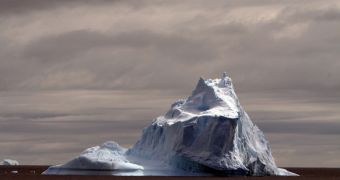According to the conclusions of a new scientific study, it would appear that icebergs melting in the world's oceans are actually helping make the waters more fertile. This is accomplished by adding more of the chemical iron into the water mixture, which in turn leads to more phytoplankton blooms.
These blooms are the primary reason why the oceans are capable of attracting and storing atmospheric carbon dioxide (CO2). The tiny microorganisms feed of the chemical, and then carry it to the ocean floor once they die. This ensures the carbon cannot escape to the surface.
The new investigation was carried out on icebergs that broke off Antarctica. Measurements conducted around them reveal that iron concentrations are higher than in any other ares. In effect, these ice mountains are releasing iron reserves that they stored through the centuries.
Investigators are saying that the total amount of iron making its way into the water is high enough to make a considerable difference. This may help explain why the waters next to ice floes are alsways teeming with life of all shapes and sizes.
Generally, sample studies conducted in these regions reveal the presence of everything from krill to fish and mammals, Science News reports. The link between biodiversity and iron concentrations in these waters has never been tested before.
“Icebergs should be considered by climate modelers, because the more icebergs that develop [from the breakup of glaciers], the more carbon dioxide you’ll draw out of the atmosphere,” explains research scientist Ken Smith.
The expert, who is based at the Monterey Bay Aquarium Research Institute, in Moss Landing, California, says that current climate simulations do not take into account the effect icebergs have on the waters they flow through.
This new study builds on data collected by Smith and his team in 2007. The conclusions the group obtained were published in the top journal Science, and elicited the attention of other research teams.
As a result, new investigations campaigns were conducted in 2008 and 2009. Nine separate research institutes were involved in the effort. Conclusions appear in a series of about 20 papers, all of them published in the June issue of Deep Sea Research Part II.
Before these studies were carried out, “we didn’t know the nature of the biological communities associated with icebergs and we certainly didn’t know their direct relationship to carbon exports,” concludes report coauthor and University of South Carolina chemist Timothy Shaw.

 14 DAY TRIAL //
14 DAY TRIAL //